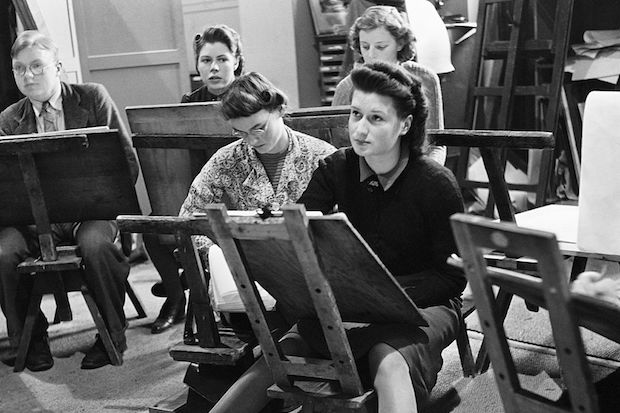The curious thing about an art room is that you never remember the look of the place. Each summer, a school art room sloughs its skin: life drawings are unpinned from the walls, maquettes carried home for the holidays, canvases taken off easels, portfolios collected by school leavers, the whole place stripped of colour and finery. The room is white and empty again, a canvas primed for September.
What stays from year to year and what lingers in the senses of former pupils is the smell. Chalk and charcoal, oils and turpentine, wet clay and slip mix, Swarfega jelly and Pritt Stick, sugar paper (a smell like damp hymn-books) and the heady, headachy vapour of hot glue guns. It’s been ten years since I left school, but I only have to open my old watercolour box to be back in the art room, fingers black with ink, and clay under my nails.
One dreams, of course, of something like the Eton art rooms. ‘More of a pavilion than an art department,’ one O.E., now a professional sculptor, tells me. ‘Vast windows, natural light, silence, white walls, space, and in the sculpture studios 19th-century plaster casts of the Parthenon Frieze above us. We did not realise then how lucky we were to create work in such beautiful surroundings.’ The dream, yes, but having worked my way through GCSE and A-level art in a cramped ground-floor room, overshadowed by London plane trees, and a dingy basement pottery studio, I would say that the room itself matters far less than the teachers, the chaos of the cupboards, the spatterings round the sink and the books, stuffed with postcard-bookmarks, on the shelves.
I had the great fortune to move at 15 from St Paul’s Girls’ School, which had a magnificent top-floor art room lit by a double-height Diocletian window, but where I was not thought good enough to do art at GCSE, to MPW in Kensington, where I was allowed to take whichever subjects I liked. I chucked physics and chemistry for pastels and paint.
Read the biography of almost any artist and you find the school art room as a place of refuge. John Piper remembered: ‘I had a generally horrible time at Epsom (as a day boy), redeemed by the protection of a delightful English master — who greatly encouraged me: I sometimes think kept me alive — and the art room.’ The red-brick art schools at Epsom College in Surrey are now named after Piper and house a collection of his work.
The cartoonist Osbert Lancaster made a sketch of his alma mater, Charterhouse, ‘on the most windswept spur of the Surrey Downs’ in a gale, boys bent double against the wind as they dashed between lessons. Charterhouse was made bearable for Lancaster by its creative history: ‘By great good fortune, there existed a long tradition of excellence in the graphic arts.’ William Makepeace Thackeray preferred doodling to Latin; Max Beerbohm caricatured the masters.
Lancaster thrived in the art room, with its well-stocked library, and on trips into the Surrey countryside in the summer term, where the art master ‘Purple’ Johnson (he had a penchant for the colour) urged the young Osbert: ‘Always remember, boy, to take a nice FULL brush.’ Today Charterhouse, which admits girls in the sixth form, has added photography dark rooms and film and animation studios to its art school. It remains howlingly windy.
North London Collegiate School has particularly splendid art rooms thanks to its wartime art mistress Peggy Angus, a ceramicist, printmaker and textile designer in her own right. Her tiles decorate the stairs to the new drawing school. She met the challenge of rationed art materials with great ingenuity (bun mould trays instead of palettes) and every year had her 11-year-olds paint a new 20ft school mural. More schools should take up Peggy’s scheme. Is there anything more dismal than miles of institutional corridor lined with lockers?
The art school at Canford, designed by the then art master Robin Noscoe in the 1960s, is a building that plays tricks. Modernist — glass and breeze blocks — on the outside, but on the inside fitted with Georgian door frames, salvaged during the demolition of 18th-century Poole.
The architect Ben Pentreath, a old Canfordian, has written about the art school’s unusually good library. ‘I was the “Art School Librarian”, which required me to re-catalogue the shelves. I’m not quite sure how we persuaded anyone that it needed hours of work, but somehow it was part of the mix that meant I completely avoided sport in the last two years of school.’
Among the more extraordinary art buildings of recent years are those at West Buckland School in Devon — larch cladding, fabulously minimalist — and at Bedales in Hampshire — a parade of lofty barns lit by picture windows.
The Evelyn Grace Academy in Brixton, designed by Zaha Hadid, is rightly proud of its art and technology block, sleek as a dorsal fin. Burntwood School in Wandsworth, a girls’ academy, rebuilt by architects Allford Hall Monaghan Morris and winner of the the 2015 RIBA Stirling Prize, has a bright and tidy suite of art and design studios (new art rooms are forgiven for being tidy, but should make every effort to become less so).
Whatever you may think of Labour’s Building Schools for the Future scheme, it has given the country some magnificent new art rooms. Bow School in Tower Hamlets, which opened in 2014, has a bank of art rooms, all with north-facing windows for the best light.
Don’t let yourself be misled, though. Picture windows and high ceilings are only ever a bonus. What you’re after is the authentic art-room smell: not new paint, but the crusted old stuff. When choosing a school for an art-inclined child, trust your nose.
The post Room for inspiration appeared first on The Spectator.
Got something to add? Join the discussion and comment below.
Get 10 issues for just $10
Subscribe to The Spectator Australia today for the next 10 magazine issues, plus full online access, for just $10.















Comments
Don't miss out
Join the conversation with other Spectator Australia readers. Subscribe to leave a comment.
SUBSCRIBEAlready a subscriber? Log in